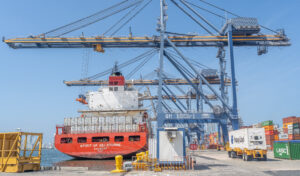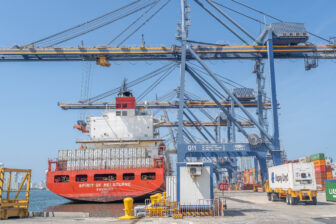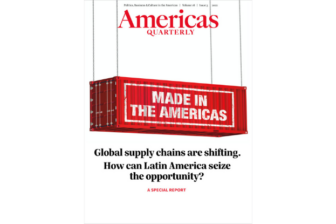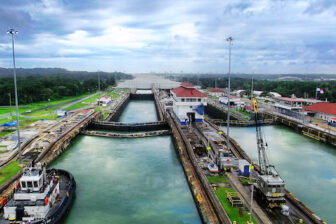This article is adapted from AQ’s special report on supply chains

José Antonio Meade
economist, former Mexican minister of foreign relations, finance and energy
It wasn’t that long ago that globalization seemed here to stay. Liberal democracies across Latin America could show important degrees of success by raising people out of extreme poverty and creating opportunities that resulted in growth and wealth accumulation. The Pacific Alliance, with its drive for greater mobility of capital, people and goods, generated excitement and promise. Dialogue ongoing between the Alliance and Mercosur made Latin American integration seem attainable. Colombia’s peace process and Cuba and U.S. rapprochement allowed us to believe that a conflict-free and global America was not only conceivable but almost inevitable.
That optimism was unfounded, and soon discontent made itself evident. Populism and challenges to democracy are now the norm, and it is deglobalization that seems here to stay. The most important thing we can do in Latin America is to try to understand what happened. What did we do well? Where did we fall short?
As we do, I believe our tragic flaw will be found in lack of access to education. The life expectancy of a Mexican without high school education is five years shorter. We need democracy and globalization, but we also need them to do better. If our democracies and policies do not result in inclusive and sustainable growth, we will fall short yet again. Nearshoring affords us great opportunities. We need more trade, not less; we need stronger democracies, not weaker institutions. But we also need greater participation in the benefits of growth. There is no other—or better—path than through access to education.

Adriana Arreaza
acting head of knowledge, director of macroeconomic studies, Development Bank of Latin America (CAF)
While a significant degree of uncertainty persists regarding the future of global value chains, Latin American economies could clearly benefit from increased nearshoring. CAF’s recent publication “RED 2021: Pathways to integration,” suggests three pillars to enhance intraregional trade within existing agreements.
The first is trade facilitation. Economies in Latin America and the Caribbean lag in standardization, harmonization, digitalization and simplification of international trade procedures. Initiatives that standardize information, such as “Single Windows” (SWs), can ease and expedite international trade procedures. SWs do not require agreements with trade partners, but their joint implementation can further reduce costs.
The second is improving infrastructure. Transportation costs outweigh even tariffs in some countries. It is necessary to improve infrastructure to minimize delays related to congestion or low-quality roads and reduce storage costs at ports or airports. Logistics corridors should be prioritized to support value chains from start to finish. Investing in maintenance, not just new projects, is also crucial.
The third pillar is productive integration. Participation in global value chains is low in Latin America, with Mexico being an exception. In contrast, Central American countries add up to 20% of the total added value of the products traded within the region. The situation is no different in Andean and Mercosur countries, incorporating 27% and 34%, respectively, into the total added value of regionally traded products. Stringent rules of origin in trade agreements can prevent firms from efficiently incorporating imported inputs into their exports. Instead, introducing “cumulation rules” allows firms to include inputs produced by other countries that are members of a trade agreement into their products while preserving their originating status. This could infuse more dynamism into exports and regional value chains. Securing foreign direct investment and removing barriers to tradable services would also favor productive integration.

Blanca Treviño
president and CEO, Softtek
When visiting one of our company’s new offices, right before the pandemic in January 2020, I was very pleased by how convenient the location is. The office, a global software development center, was on the 15th floor of a modern building, adjacent to a shopping mall with a Starbucks, a Pizza Hut, an Apple store and several well-known fashion outlets.
This office is in Wuxi, China. And yet, very similar arrangements occur at our centers in Mexico City, as well as a former office in São Paulo, Brazil. The overall experience (outside of signs and passersby using the local language) is completely interchangeable.
Latin America can be the cream of the crop when it comes to nearshoring. When we introduced the concept of nearshore IT services, back in 1997, we thought of it as a complement to the prevailing India offshore outsourcing model. At the time, India had already established its position as a premier provider of high-quality information technology services. Our proposition was not to replace India, but rather to leverage proximity and cultural similarities to help our clients in the U.S. do the things they couldn’t do effectively with teams on the opposite side of the world.
Throughout the years, the nearshore model has proven to be an extremely valuable strategy, like having an adjacent shopping mall with familiar brands. And it is already happening for many of us.

Magdalena Bas Vilizzio
professor of public international law, University of the Republic of Uruguay, member of Uruguay’s National Researchers System, postdoctoral fellow, University of Monterrey, Mexico
Hyper-globalization has been in retreat since 2008, and the COVID-19 pandemic, the Russia-Ukraine conflict and the persistent crisis of the global supply chain are driving the world towards a new era in globalization. To face this scenario, Latin American countries need to improve communication with civil society as well as put human rights at the center of all trade and investment agreements. But first and foremost, the region needs to overcome its internal fragmentation.
Disagreements over the recent Mercosur-EU agreement constitute one of the best-known examples of regional division. Other symptoms include regulatory inefficiency, declining intra-regional trade and the lack of common positions in multilateral organizations (for instance in relation to the Russia-Ukraine conflict).
Overcoming these disagreements would allow us to better address issues of interest to the entire region: climate change and the transition to green energies, low economic growth—projected at just 1.8% in 2022 according to ECLAC’s April projections—or health emergencies such as COVID-19, cholera or dengue fever. Moreover, it is also an opportunity to discuss and coordinate other public policies that impact economic and security issues. Examples include front-of-pack nutrition labeling, where Mexico and Chile are regional leaders, and supply chain ethics regulation such as the recent German Supply Chain Act requiring companies to follow ESG requirements when selecting suppliers.










